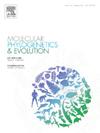Disentangling the evolutionary history of terrestrial planarians through phylogenomics
IF 3.6
1区 生物学
Q2 BIOCHEMISTRY & MOLECULAR BIOLOGY
引用次数: 0
Abstract
Triclads (Platyhelminthes, Tricladida) are found in marine, freshwater, and terrestrial habitats worldwide except Antarctica. Terrestrial planarians are grouped into the family Geoplanidae, which is subdivided into the subfamilies Geoplaninae, Bipaliinae, Rhynchodeminae, and Microplaninae. Some of these subfamilies result from taxonomic rearrangements based on molecular phylogenies inferred from a few molecular markers. However, the diagnosis of Rhynchodeminae was not aligned with the morphology of all its representatives. While the subfamilies are recovered as monophyletic in recent molecular phylogenies, robust hypotheses regarding the relationships between them remain unknown. In this study, we employ for the first time a phylogenomic framework to investigate the evolutionary relationships among the subfamilies, starting by obtaining the first transcriptomes for 15 species of terrestrial planarians. A total of 16 different datasets, comprising nearly two thousand single-copy genes inferred from transcriptomic data, were analyzed using various phylogenetic inference methods. We recovered, for the first time, a well-supported topology of phylogenetic relationships among Geoplanidae subfamilies, positioning Bipaliinae and Microplaninae as a clade sister to Rhynchodeminae + Geoplaninae. Internal relationships within the genus Microplana were not supported in our analyses. The subfamily Rhynchodeminae, represented in our phylogeny by species from the tribes Rhynchodemini and Caenoplanini, is re-diagnosed to align with previous taxonomic rearrangements. This study not only represents a significant step forward in the phylogenetic resolution of Geoplanidae but also provides important insights into the broader evolutionary dynamics shaping land planarian diversity.

通过系统基因组学解开陆生涡虫的进化史。
除南极洲外,在世界各地的海洋、淡水和陆地栖息地都发现了三瓣虫(platyhelmintes, Tricladida)。陆生涡虫被归为涡虫科,涡虫科又被细分为涡虫亚科、双涡虫亚科、尾涡虫亚科和微涡虫亚科。其中一些亚科是基于从一些分子标记推断的分子系统发育的分类重排而产生的。然而,Rhynchodeminae的诊断与所有代表的形态学不一致。虽然亚家族在最近的分子系统发育中被恢复为单系,但关于它们之间关系的强有力的假设仍然未知。在这项研究中,我们首次采用系统基因组框架来研究亚科之间的进化关系,首先获得了15种陆生涡虫的第一个转录组。共有16个不同的数据集,包括近2000个从转录组学数据推断的单拷贝基因,使用各种系统发育推断方法进行了分析。我们首次恢复了Geoplaninae亚科之间系统发育关系的良好支持拓扑结构,将Bipaliinae和Microplaninae定位为Rhynchodeminae + Geoplaninae的分支姐妹。在我们的分析中不支持Microplana属的内部关系。在我们的系统发育中,以Rhynchodemini和caenplanini部落的物种为代表的Rhynchodeminae亚科被重新诊断,以与先前的分类重排保持一致。这项研究不仅代表了地涡虫科系统发育研究的重要一步,而且为塑造陆地涡虫多样性的更广泛的进化动力学提供了重要的见解。
本文章由计算机程序翻译,如有差异,请以英文原文为准。
求助全文
约1分钟内获得全文
求助全文
来源期刊
CiteScore
7.50
自引率
7.30%
发文量
249
审稿时长
7.5 months
期刊介绍:
Molecular Phylogenetics and Evolution is dedicated to bringing Darwin''s dream within grasp - to "have fairly true genealogical trees of each great kingdom of Nature." The journal provides a forum for molecular studies that advance our understanding of phylogeny and evolution, further the development of phylogenetically more accurate taxonomic classifications, and ultimately bring a unified classification for all the ramifying lines of life. Phylogeographic studies will be considered for publication if they offer EXCEPTIONAL theoretical or empirical advances.

 求助内容:
求助内容: 应助结果提醒方式:
应助结果提醒方式:


